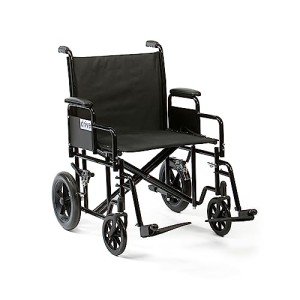Bariatric Wheelchair Seat Width
Seat Width
Having the right seat width is essential to wheelchair users who invest longer durations in their chairs. Too narrow a seat will cause pressure on the hips and thighs which might lead to sores or pressure points. Having too large a seat can likewise make it difficult for the user to reach the hand rims to move themselves or maneuver in small spaces.
To measure the proper seat width an individual would rest on a chair generally and have their measurement taken across their lap at the widest point which is generally their hips. A wheelchair determining tape can be utilized to measure this, however a yard stick is chosen as it prevents people from covering the tape around their hips which would give an incorrect result.
The basic wheelchair seat width is 16" (narrow grownup), 18" (basic grownup), and 20" (broad grownup). For bariatric patients, a 24" seat is offered. My Mobility Scooters from Medline includes swing-away footrests, a carbon steel frame with rust- and chip-resistant chrome plating, and easy-to-clean vinyl upholstery. It has a weight capacity of 500 pounds.
Seat Depth
Traditionally, the seat depth of a bariatric wheelchair was included 2" to the measurement taken at the user's largest point (normally their hips). This was indicated to accommodate extra layers of clothes that might be worn throughout cold weather condition. Nevertheless, this practice is ending up being less common as wheelchair users are able to invest more time inside your home and are not wearing long coats. This makes the seat depth of a chair less important when selecting a bariatric wheelchair. Nevertheless, it is still important to select an option that uses appropriate assistance for larger users.
The Medline folding additional wide bariatric manual wheelchair includes a comfy 24" seat width and a durable slide tube silver vein frame. It likewise has an adjustable axle and tool-free elevating legrests.
Seat Height
When it concerns determining the right wheelchair seat width you must always measure from the user's largest point which is typically their hips. You will likewise require to consider whether the user is going to be wearing a winter coat as this might add 2" to the width needed.
When a wheelchair is in usage it must just be operated on level surfaces with the wheel locks totally engaged. This is to prevent the chair from being able to move inclines that are 10 degrees or higher. It is likewise essential to bear in mind that any activity that might shift the center of mass in the chair should be finished with care. This includes reaching for products that need the individual to lean out of their seat or attempting to stand from it.

Whenever you have the chair in usage it is suggested that you routinely check it for damage and oil any areas that are considered necessary. For example, the casters need to be lubricated by eliminating the caster fork and using a multi-purpose grease to use to the caster stem bearings. Likewise, the foot plates can be changed by loosening the bolt and then moving them to the preferred position. This allows the feet to sit conveniently on the footplate and avoids any pressure points from forming. This can be really uneasy for the user and if left unattended, can result in press sores.
Weight Capacity
Bariatric wheelchairs are developed to support more weight than basic wheelchairs. This makes them stronger and much better equipped to deal with falls. They are also typically larger and larger, making them less maneuverable in tight areas than standard wheelchairs. They require cars with unique ramps and lifts to load them, along with motorists who understand how to finest transport them from one location to the next.
When choosing a wheelchair, consider its weight capacity as it will be the main determining element in whether it will accommodate your passenger's needs. The weight capacity of the chair is frequently listed as a fixed load, meaning that it shows the quantity of weight the chair can conveniently hold while stalling. Nevertheless, some manufacturers likewise list an active load that is based upon a drop test and can imitate the impact of somebody taking a seat in the chair. This may be a more reputable measurement of the weight limit, depending upon your needs.
If you plan to carry out activities that move your center of gravity in the seat (such as grabbing things), make certain to have front casters pointed in a forward instructions and wheel locks engaged so the chair will not tip over. Likewise, inspect that casters are lubed regularly to avoid excessive wear and abrasions. The lubrication procedure involves eliminating the fork, separating the caster from the wheel, and greasing the caster stem bearings with high-quality multi-purpose grease.
